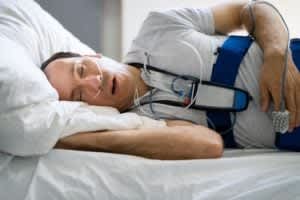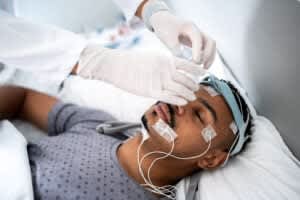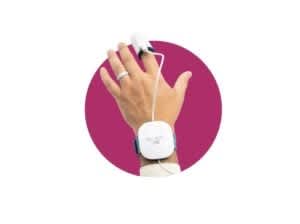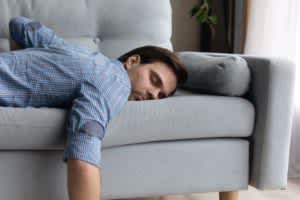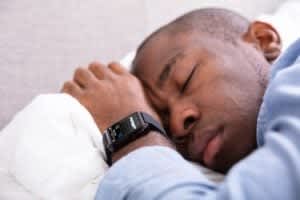Price:
$179When you buy through our links, we may earn a commission. Products or services may be offered by an affiliated entity. Learn more.
Ectosense NightOwl Review
The content on this page should not be taken as medical advice, nor do we claim this test reflects diagnosis. Always consult your doctor in regards to using this device and any test results it may indicate.
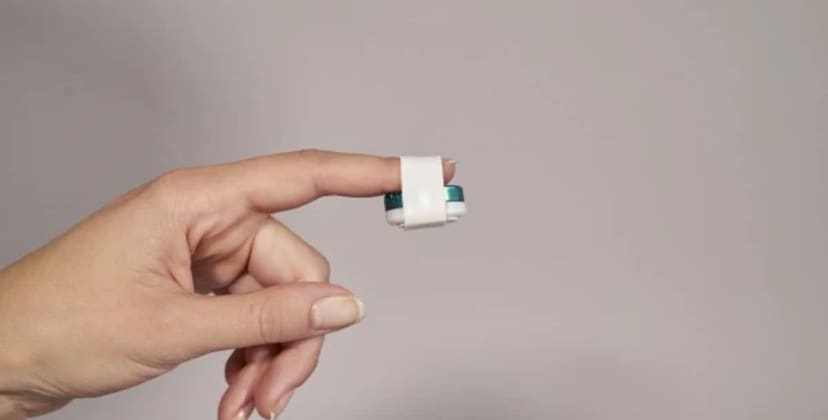
Ectosense NightOwl

Sleep Foundation Special Offer
Use this SleepFoundation.org link for the most current discount on Ectosense products
The Ectosense NightOwl is an app-based home testing device for obstructive sleep apnea (OSA). Using your fingertip as a contact point, the NightOwl measures your breathing patterns to determine whether you meet diagnostic criteria for OSA.
The NightOwl Companion app allows you to pair the device with your phone and send data directly to your physician. Standard NightOwl devices are rechargeable and can record approximately 25 hours of data per charge. Ectosense also sells the NightOwl Mini, which costs less but can only be used 10 times.
As with other home-based sleep apnea tests, the NightOwl is more affordable and more convenient than undergoing an overnight sleep study. The device is also small and lightweight, so it shouldn’t lead to sleep disruptions.
We’ll cover how to acquire, set up, and use the NightOwl, how the device works, and additional steps you’ll need to take after completing your at-home test.
What Is Obstructive Sleep Apnea?
OSA is a sleep disorder that causes people to temporarily lose their breath during sleep and wake up choking or gasping for air. The disorder occurs due to a physical obstruction restricting airflow through the breathing passages.
Obstructions that can cause sleep apnea include swollen tonsils or adenoids or having a large tongue or a relatively short lower jaw. Obesity is also considered a major risk factor for OSA. People with OSA often snore heavily.
The disorder can lead to nightly sleep disruptions, which can lead to feelings of grogginess and fatigue the next day and in turn can have a negative effect on quality of life and overall health. OSA is also associated with long-term health problems such as heart failure and stroke, as well as mental health conditions like depression and anxiety.
If you experience OSA symptoms, receiving a diagnosis is essential for getting the treatment you need. Using a home testing device like the Ectosense NightOwl can be a crucial first step for people with this condition.
How Does the Ectosense NightOwl Work?
The NightOwl detects sleep apnea symptoms with a sensor that attaches to your fingertip. The device uses both an accelerometer and photoplethysmography (PPG) to record the following metrics:
- Actigraphy: The NightOwl features a built-in accelerometer to track actigraphy, which is a measure of body motion. By monitoring limb movements, the device is able to determine when the user is asleep or awake.
- Blood oxygen level: The device uses PPG technology to monitor blood oxygen level, which decreases during a sleep apnea event.
- Peripheral arterial tone (PAT): PAT is a measure of changes in pulse volume. A person’s heart rate and blood pressure decrease during an apnea event and increase when they begin breathing again, making PAT a valuable tool for the detection of OSA.
- Apnea-hypopnea index (AHI): AHI is a scale used to measure OSA severity that’s calculated by dividing the total number of episodes of shallow or halted breathing by the total number of hours a person is asleep. The NightOwl uses the three aforementioned bodily metrics to calculate an AHI score.
Finger sensors are often used in overnight sleep tests conducted in labs, also known as polysomnography. Sensors measuring other contact points such as your wrist and chest may also be used during sleep studies.
Since the NightOwl only attaches to your finger, the device is less invasive than instruments used in polysomnography. By the same token, the NightOwl’s data-collecting capabilities are more limited.
How Do You Buy and Set Up the Ectosense NightOwl?
The NightOwl requires a prescription from a licensed physician. You can obtain the device through your doctor. Alternatively, the NightOwl is widely available for purchase online.
If you decide to buy the NightOwl online, you’ll need to be approved for the device. The online seller you choose will connect you with a doctor for a virtual consultation, during which they determine whether you qualify for a home sleep study. The doctor bases their decision on factors like your age, weight, habits, and sleep history. If you’re approved for the NightOwl, the doctor writes you a prescription for the device.
To use the NightOwl, you’ll need to download the NightOwl Companion app. This free app is available through the Apple Store and Google Play and is compatible with most iOS and Android devices. The device comes with an activation code that is required to use the app.
How Do You Use the Device and the NightOwl Companion App?
Once the NightOwl arrives and the app is fully downloaded, you’ll need to follow these steps:
- Set up the app: Open the app and input the activation code. You can manually enter the number or scan the QR code using your phone’s camera. After accepting the app’s terms and conditions, you’ll need to fill out a brief personal health questionnaire to complete the app setup.
- Pair the NightOwl to your phone: Press the small button on the sensor until a red light flashes, then tap the “start connecting” button on the app. You’ll receive an in-app notification when the devices are successfully paired.
- Secure the device: Your package should include adhesive finger straps. Place the NightOwl against the tip of your index finger. Make sure the side with the flashing light is pressed against your fingertip, then wrap the adhesive strap around the finger. The strap should be tight enough to prevent the NightOwl from shifting, but still comfortable for sleep.
- Take the test: When you go to bed, press the “start recording” button on the app. Your phone will track data from the NightOwl sensor throughout the night. To maintain consistent pairing, you’ll need to keep your phone within six feet of the sensor. You should also ensure the phone is fully charged. At least four hours’ worth of data is needed to generate accurate results.
- Send the results to your doctor: Tap “wake up” on the app after getting out of bed. This will turn off the sensor and upload your data onto your phone. You’ll be prompted to answer a quick survey about how you slept. Complete the survey and then tap “submit.” The data is then sent to your doctor.
Your doctor will review the data and go over the results during a follow-up consultation. This may lead to a diagnosis. Alternatively, they may recommend further testing.
Who Should Use the Ectosense NightOwl?
The NightOwl is approved by the Food and Drug Administration (FDA) for use by people 13 and older with a doctor’s prescription. People who show symptoms of moderate to severe OSA may be good candidates for an at-home test.
Common symptoms of OSA include:
- Loud snoring, choking, or gasping during sleep
- Restless sleeping and frequently waking to urinate
- Morning headaches
- Dry mouth or sore throat upon waking
- Difficulty with memory or concentration during the day
- Fatigue or excessive daytime sleepiness
People who have not consulted with their doctor about using the NightOwl should refrain from using the device until they do so.
Pros and Cons of the Ectosense NightOwl
The NightOwl has some advantages over traditional sleep studies and other at-home sleep apnea tests.
- Below-average price: The NightOwl’s cost varies by seller, but the device is widely available for less than $200. This makes it more affordable than many competing at-home sleep apnea tests. Depending on the seller, you may need to pay an additional fee for more than one night of testing.
- Comfort: The NightOwl is lightweight and doesn’t need to be wrapped too tightly, so most wearers don’t experience sleep disruptions. Other at-home tests feature additional components such as wristbands and chest monitors that can have a greater impact on sleep.
- Convenience: The NightOwl allows you to test for OSA while sleeping in your own bed as opposed to spending the night in a sleep lab.
- Ease of use: Instructions for setting up the NightOwl are fairly straightforward.
There are also some drawbacks to using the NightOwl, including:
- Potential ineffectiveness: Since the NightOwl only uses one point of contact on your body to derive data, your results may not be as comprehensive compared with a device that uses additional contact points. That said, the NightOwl may still record enough data for your doctor to make a recommendation.
- User complaints: Based on Apple Store and Google Play reviews, user experiences with the NightOwl Companion app have been mixed. These complaints may be due to improper use or device pairing.
- Doesn’t detect central sleep apnea: Unlike more advanced at-home testing devices that include chest sensors, the NightOwl is not designed to detect central sleep apnea (CSA), a less common sleep disorder in which the brain briefly fails to send signals to the muscles that control breathing.
Ectosense NightOwl: The Bottom Line
The Ectosense NightOwl is one of the lightest and least obtrusive home testing devices for OSA on the market. It’s also one of the most affordable, and the multi-use design is helpful if you don’t record conclusive data on the first night of testing.
However, like other at-home testing devices, it may not be a suitable option for people who display symptoms of mild OSA, due to the potential of overestimating AHI score. It also lacks the more comprehensive testing capabilities of devices that include wrist and chest sensors and microphones to record snoring.
Before purchasing the NightOwl, talk to your doctor about your symptoms and ask if they think the device is right for you.

Still have questions?
Our product experts have extensive experience testing just about every sleep product on the market. Send an email to [email protected] or call us at (877) 672-8966 with your questions and we’ll help you find exactly what you’re looking for.

